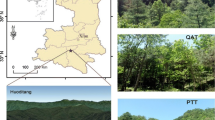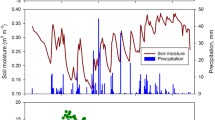Abstract
Quercus serrata Thunb. ex Murray is a widespread deciduous oak in China, the Korean Peninsula, and Japan, and a strong isoprene emitter. Establishing accurate inventories of this species and estimating net carbon budgets, including biogenic volatile organic compounds (BVOC), necessitates detailed evaluation of BVOC emission and oxidation characteristics. Emissions of isoprene, the most abundant BVOC, presumably contribute to atmospheric chemistry through the formation of photochemical oxidants and secondary organic aerosols. We built an isoprene flux monitoring system to simultaneously reveal characteristics of the flux and fate of isoprene at multiple locations in Q. serrata forests. We used proton transfer reaction mass spectrometry (PTR-MS) and an automated closed chamber to measure isoprene emissions from soil and leaves in a warm-temperate Q. serrata forest. We used a relaxed eddy accumulation system with PTR-MS to simultaneously measure the canopy flux. In continuous foliage chamber measurements, we observed daily variations of isoprene emissions and continuous nocturnal emissions from leaves. Nocturnal emissions exceeded 25 % of total daily leaf emissions and were relatively high at sunset and low at sunrise. These results suggest that nocturnal emissions from mature trees may not be negligible. When leaf emissions were high in the daytime, the canopy isoprene flux tended to plateau at an upper limit. Observations of isoprene concentrations and gradients suggest that the plateau was caused by acceleration of isoprene oxidation, and sequential formation of secondary organic aerosols may occur near the leaf just after emission. Elucidation of these linkages may require continuous field measurements with a simultaneous multi-flux monitoring system.









Similar content being viewed by others
References
Brüggemann N, Schnitzler JP (2002) Comparison of isoprene emission, intercellular isoprene concentration and photosynthetic performance in water-limited oak (Quercus pubescens Willd. and Quercus robur L.) saplings. Plant Biol 4:456–463
Businger JA, Oncley SP (1990) Flux measurement with conditional sampling. J Atmos Ocean Technol 7:349–352
Carter WPL, Atkinson R (1996) Development and evaluation of a detailed mechanism for the atmospheric reactions of isoprene and NOx. Int J Chem Kinet 28:497–530
Dannoura M, Kominami Y, Tamai K, Jomura M, Miyama T, Goto Y, Kanazawa Y (2006) Development of an automatic chamber system for long-term measurements of CO2 flux from roots. Tellus B 58:502–512
Ganzeveld L, Eerdekens G, Feig G, Fischer H, Harder H, Kónigstedt R, Kubistin D, Martinez M, Meixner FX, Scheeren HA, Sinha V, Taraborrelli D, Williams J, Vilà-Guerau de Arellano J, Lelieveld J (2008) Surface and boundary layer exchanges of volatile organic compounds, nitrogen oxides and ozone during the GABRIEL campaign. Atmos Chem Phys 8:6223–6243
Guenther A, Zimmerman PR, Harley PC (1993) Isoprene and monoterpene emission rate variability: model evaluations and sensitivity analysis. J Geophys Res 98 (D7):12609–12617
Guenther A, Hewitt CN, Erickson D, Fall R, Geron C, Graedel T, Harley P, Klinger L, Lerdau M, Mckay WA, Pierce T, Scholes B, Steinbrecher R, Tallamraju R, Taylor J, Zimmerman P (1995) A global model of natural volatile organic compound emissions. J Geophys Res 100(D5):8873–8892
Guenther A, Karl T, Harley P, Wiedinmyer C, Palmer PI, Geron C (2006) Estimates of global terrestrial isoprene emissions using MEGAN (model of emissions of gases and aerosols from nature). Atmos Chem Phys 6:3181–3210
Hamotani K, Uchida Y, Monji N, Miyata A (1996) A system of the relaxed eddy accumulation method to evaluate CO2 flux over plant canopies. J Agric Meteorol 52:135–139
Hamotani K, Monji N, Yamaguchi K (2001) Development of a long-term CO2 flux measurement system using REA method with density correction. J Agric Meteorol 57:93–99
Hansel A, Jordan A, Warneke C, Holzinger R, Lindinger W (1998) Improved detection limit of the proton-transfer reaction mass spectrometer: on-line monitoring of volatile organic compounds at mixing ratios of a few pptv. Rapid Commun Mass Sp 12:871–875
Hewitt CN, Ashworth K, Boynard A, Guenther A, Langford B, MacKenzie AR, Misztal PK, Nemitz E, Owen SM, Possell M, Pugh TAM, Ryan AC, Wild O (2011) Ground-level ozone influenced by circadian control of isoprene emissions. Nat Geosci 4:671–674
Karl T, Guenther A, Turnipseed A, Tyndall G, Artaxo P, Martin S (2009) Rapid formation of isoprene photo-oxidation products observed in Amazonia. Atmos Chem Phys 9:7753–7767
Kawamoto J, Okumura M, Tohno S, Kominami Y, Miyama T (2010) Characterization of organic aerosols from isoprene at a forested site in Japan. In: Proceeding of the International Aerosol Conference 2010, P3W34
Kesselmeier J, Ciccioli P, Kuhn U, Stefani P, Biesenthal T, Rottenberger S, Wolf A, Vitullo M, Valentini R, Nobre A, Kabat P, Andreae MO (2002) Volatile organic compound emissions in relation to plant carbon fixation and the terrestrial carbon budget. Global Biogeochem Cycles 16:1126–1134
Kominami Y, Miyama T, Tamai K, Nobuhiro T, Goto Y (2001) Seasonal variation of CO2 flux over a deciduous broad-leaved forest in Japan—Preliminary result from observation 2000. In: Proceedings of International Workshop for Advanced Flux Network and Flux Evaluation, pp 149–152
Kominami Y, Miyama T, Yoshimura K, Ataka M, Dannoura M, Jomura M (2011) Reaction of transpiration stream flow rate on water stress in warm temperate deciduous broadleaved forest. In: Proceedings of the 52nd Annual Meeting of the Ecological Society of Japan, pp 295 (in Japanese)
Lindinger W, Hansel A, Jordan A (1998a) On-line monitoring of volatile organic compounds at pptv levels by means of Proton-Transfer-Reaction Mass Spectrometry (PTR-MS) medical applications, food control and environmental research. Int J Mass Spectrom Ion Process 173:191–241
Lindinger W, Jordan A, Hansel A (1998b) Proton-transfer-reaction mass spectroscopy (PTR-MS): on-line monitoring of volatile organic compounds at pptv levels. Chem Soc Rev 27:347–534
Matsunaga S, Mochida M, Kawamura K (2003) Growth of organic aerosols by biogenic semi-volatile carbonyls in the forestal atmosphere. Atmos Environ 37:2045–2050
Miyama T, Kominami Y, Tamai K, Nobuhiro T, Goto Y (2003) Automated foliage chamber method for long-term measurement of CO2 flux in the uppermost canopy. Tellus B 55:322–330
Mochizuki T, Tani A, Yasuda T, Ueyama M, Hamotani K, Takahashi Y, Yonemura S, Okumura M, Tohno S, Miyama T, Kominami Y (2011) Development of a portable relaxed eddy accumulation devise and its application for terpenoid flux measurement above a larch forest. Eco-Eng 23(3):81–88 (in Japanese with English summary)
Okumura M, Tani A, Kominami Y, Takanashi S, Kosugi Y, Miyama T, Tohno S (2008) Isoprene emission characteristics of Quercus serrata in a deciduous broad-leaved forest. J Agric Meteorol 64(2):49–60
Schnitzler JP, Graus M, Kreuzwieser J, Heizmann U, Rennenberg H, Wisthaler A, Hansel A (2004) Contribution of different carbon sources to isoprene biosynthesis in poplar leaves. Plant Physiol 135:152–160
Tani A, Hayward S, Hewitt CN (2003) Measurement of monoterpenes and related compounds by proton transfer reaction-mass spectrometry (PTR-MS). Int J Mass Spectrom 223–224:561–578
Tuazon EC, Atkinson R (1990) A product study of the gas-phase reaction of methacrolein with the OH radical in the presence of NOx. Int J Chem Kinet 22:591–602
Ueyama M, Hamotani K, Nishimura S (2009) A technique of high-accuracy flux measurement by a relaxed eddy accumulation system with a new averaging strategy. J Agric Meteorol 65:315–325
Wiberley AE, Donohue AR, Westphal MM, Sharkey TD (2009) Regulation of isoprene emission from poplar leaves throughout a day. Plant Cell Environ 32:939–947
Acknowledgments
We acknowledge Mr. S. Chikaguchi, S. Narayama (Forestry and forest products research institute), and Dr. A. Shimono (Shoreline Science, Inc.) for dedicated support on field measurements. We also thank two anonymous reviewers for their helpful comments and suggestions. This work was partly supported by the A3 foresight program of JSPS (CarboEastAsia), the Global Environment Research Account for National Institutes (FY2007–2011) and the Global Environment Research Fund (RF-0903, B-1105) of the Ministry of the Environment, Japan.
Author information
Authors and Affiliations
Corresponding author
About this article
Cite this article
Miyama, T., Okumura, M., Kominami, Y. et al. Nocturnal isoprene emission from mature trees and diurnal acceleration of isoprene oxidation rates near Quercus serrata Thunb. leaves. J For Res 18, 4–12 (2013). https://doi.org/10.1007/s10310-012-0350-5
Received:
Accepted:
Published:
Issue Date:
DOI: https://doi.org/10.1007/s10310-012-0350-5




